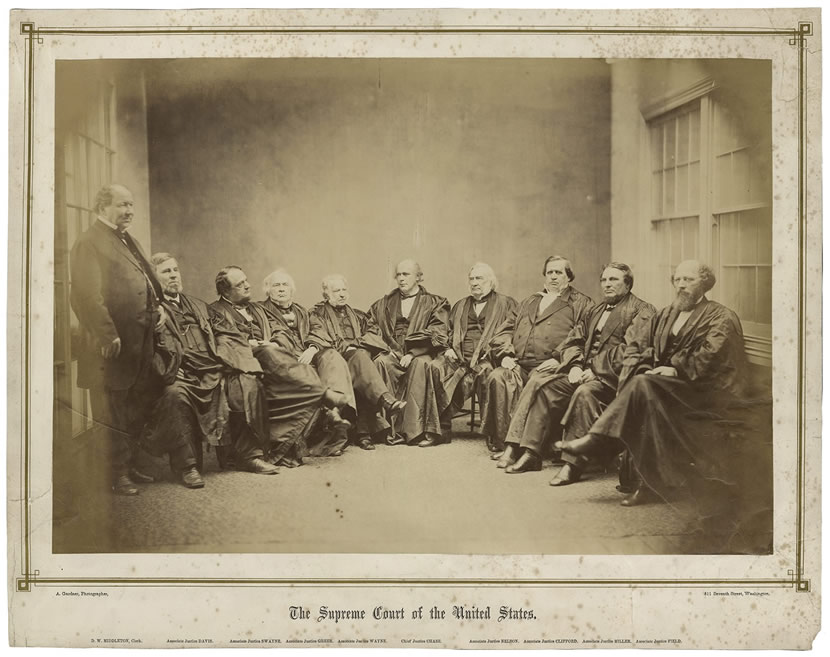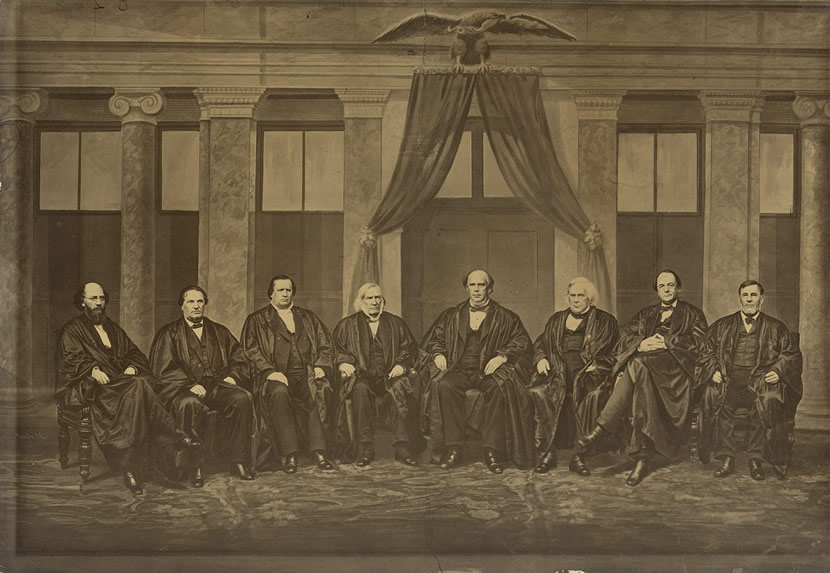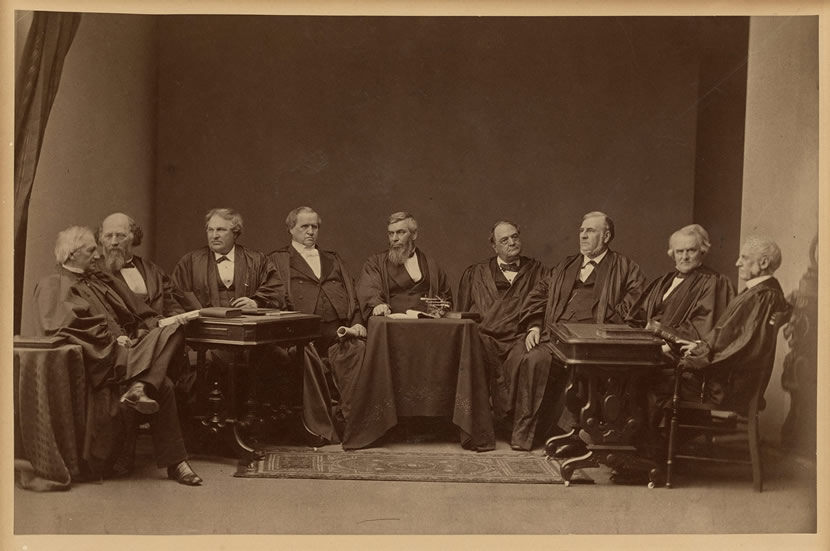All Together for the Camera:
A History of the Supreme Court’s Group Photograph
1867-1870s: On the Bench
The earliest photographers to take group photographs depicted the Justices in a single row, as they were seen on the Bench from the perspective of a visitor attending Court.
The Chase Court, February 1867
Alexander Gardner (1821-1882)
 Left to right: Clerk D.W. Middleton, Justices David Davis, Noah H. Swayne, Robert C. Grier, and James M. Wayne, Chief Justice Salmon P. Chase, and Justices Samuel Nelson, Nathan Clifford, Samuel F. Miller and Stephen J. Field
Left to right: Clerk D.W. Middleton, Justices David Davis, Noah H. Swayne, Robert C. Grier, and James M. Wayne, Chief Justice Salmon P. Chase, and Justices Samuel Nelson, Nathan Clifford, Samuel F. Miller and Stephen J. Field
On February 23, 1867, the Supreme Court Justices made their way to Alexander Gardner’s Photographic Gallery at Seventh and D Streets, N.W., in downtown Washington, D.C. to pose for a group portrait for the first time. Soon afterward a local newspaper, probably repeating Gardner’s own wording, described it as showing “…the Supreme Court ‘on the bench,’ costumed in the ‘robes of office,’ with the clerk of the court in attendance in citizen’s dress.” This is the only time the Justices have ever been joined by anyone else for such a photograph.
When the exhibit opened in 2017, the Court’s faded original print, made in 1867, was not available and another print from 1904 was too dark and not acceptable, so a modern print was created that was a unique synthesis of both. Darker areas, such as the robes, were copied from the faded original, and the brighter highlights were copied from the darker print. Thus, the first group photograph in the exhibit is an example of 21st century printmaking in which only the best qualities of two separate prints are combined into a single print.
Click on the arrows in the picture below to see them in sequence.
1 / 3
An original print by Gardner, c. 1867.
2 / 3
A 1904 print, made by Henry Martin of Ambler, Pennsylvania.
3 / 3
The digitized merger of both prints.
❮
❯
The Chase Court, c. March-April 1868
Studio of Mathew Brady (1823-1896)
 Note: under the provisions of the Judiciary Act of 1866, the Court had eight members in early 1868.
Note: under the provisions of the Judiciary Act of 1866, the Court had eight members in early 1868.
Left to right: Justices Stephen J. Field, Samuel F. Miller, Nathan Clifford and Samuel Nelson, Chief Justice Salmon P. Chase, and Justices Robert C. Grier, Noah H. Swayne, and David Davis
The Supreme Court’s second group photograph was created by Mathew Brady, one of the most important 19th century American photographers, and his studio manager E. L. Townsend. At the time, Brady was well known to all of the Justices. Not only had he already photographed each of them individually, but he had photographed nearly every sitting Justice since the 1840s as part of his goal to create a “national gallery” of portraits of every distinguished American. However, in this case his motivation may have been professional jealousy that his former assistant, Gardner, had photographed the Court before he did.
Brady spared no expense for the final result. It began as a composite of four separate photographs of the Justices, posing individually or in small groups. After the time-consuming process of creating a plausible montage of the Justices was finished, they were superimposed over a painting of the courtroom made by Brady’s in-house painter, Carl Bersch.
Click on the arrows in the picture below to see how this montage came together.
1 / 5
Brady started with a photograph of Justices Grier and Davis…
2 / 5
…added a second of Justices Miller, Clifford, Nelson and Chief Justice Chase…
3 / 5
…then added a separate photograph of Justice Field…
4 / 5
…and a fourth of Justice Blatchford, then…
5 / 5
…combined them in front of the painted background.
❮
❯
The Waite Court, Spring 1876
S. M. [Samuel Montague] Fassett (1825-1910)
 Left to right: Justices Joseph P. Bradley, Stephen J. Field, Samuel F. Miller, Nathan Clifford, Chief Justice
Morrison R. Waite, and Justices Noah H. Swayne, David Davis, William Strong and Ward Hunt
Left to right: Justices Joseph P. Bradley, Stephen J. Field, Samuel F. Miller, Nathan Clifford, Chief Justice
Morrison R. Waite, and Justices Noah H. Swayne, David Davis, William Strong and Ward Hunt
In early 1876, the Justices agreed to pose for a group portrait to be exhibited at the Centennial Exposition in Philadelphia that spring.
Artist Cornelia Adèle Fassett, who made the final drawing, often worked from photographs taken by her husband, photographer Samuel Montague
Fassett. Samuel made several photographs of the Justices in his studio, while Cornelia probably arranged the details of each of the various
poses with her final drawing in mind.
“The Supreme Court of the United States 1876”
S. M. [Samuel Montague] Fassett (1825-1910) and Cornelia Adèle Fassett (1831-1898)
The Fassetts then reproduced copies of the drawing for sale to tourists and mounted them on colored board with facsimiles of the Justices’
signatures printed beneath. Although the signatures are not real, and the picture is of a drawing, this souvenir is the first known example of
what would soon become a tradition in its own right: the autographed group photograph.
Cornelia Adèle Fassett’s original conté crayon drawing is included in the exhibit, Forgotten Legacy: Judicial Portraits by Cornelia Adèle Fassett, located on the ground floor of the Supreme Court Building.